Queer Experiences of Religion: How Marginalization within a Religion Affects Its Queer Members
Abstract
1. Introduction
1.1. Religiosity
Religion and Psychological Distress
1.2. Marginalization
Queer Religious Marginalization
1.3. The Current Study
2. Materials and Methods
2.1. Participants
2.2. Measures
2.2.1. Queer Status
2.2.2. Psychological Distress
2.2.3. Life Satisfaction
2.2.4. Strength of Faith
2.2.5. Marginalization
2.3. Procedure
2.3.1. Quantitative
2.3.2. Qualitative
3. Results
3.1. Quantitative Analysis
3.2. Qualitative Analysis
3.2.1. Ideals
I much preferred the doctrine of Orthodoxy but knew there was no place for my queerness there. Ever since then, I have not affiliated myself with any one denomination over another, and instead think of myself as ‘just Jewish’. I still struggle with accepting my queerness knowing what I do about Torah Judaism, and have not returned to any Orthodox spaces because I know I would be marginalized.
Growing up the church would always say things like it was evil or against God for me to like girls, dress androgynously, or have dreams or goals that did not involve motherhood and marriage. My family was very religious and I got dragged to things a lot and was always told they would pray for me or pray that I would find salvation for my ‘sins’. I was always a good kid, never drank or did drugs, was not promiscuous, gave to the poor, did volunteer work, etc but simply because I was LGBT I was never good enough because of my ‘sins’.
For the longest time I thought I can’t be LGBTQ AND religious. I could either have the dangerous, exciting, glittery, smoky haze of being queer or the soft, wholesome light of faith, but not both. I didn’t come out til I was 13 as bisexual–my youth pastor told me that so long as I never acted upon feelings for the same sex, I would go to heaven. Like this was just my cross to bear.
I’m really lucky because, in the Buddhist community I’m part of, people are cool with me being non-binary. Buddhism is all about understanding and kindness, so the folks around me are supportive…This acceptance lets me be myself without feeling left out. Buddhism’s teachings about being mindful and compassionate really help create an environment where everyone, no matter their identity, is treated with respect. It’s nice to see how Buddhism can be a way for people to come together and accept each other, making it easier for me to be true to who I am.
3.2.2. Actions
Positive Valence
Our local congregation is overwhelmingly queer (we joke that we have one or two token straight folks), we participate in local pride events all throughout the state, we attend queer cultural events. I myself am a member of our local Rocky Horror cast and several members of our congregation are regular attendees at our shows.
Negative Valence
As a Christian, it’s really hard to be gay, and even harder to express a gender identity outside of cis. I realized I was queer when I was about 13 years old and it terrified me, because I grew up understanding that my religion looked at gay people as an abomination, or something to be disgusted by. It was painful, and a journey. But now, I feel more at peace knowing that the God I believe in is not that way.
Thankfully, I have always been around progressive members of my own faith so acceptance of my queer identity has always been a privilege for me. But there is still that fear that the moment I step out of my own small community, that I will experience prejudice from those in the broader sense of my religion. I suppose that’s why I’m often scared to truly immerse myself in my faith.
I am out to a considerable amount of people and I am always misgendered and dead-named. I hate that even my family will not respect my identity, so I try hard to distance myself from them. I find myself more accepted by people I barely know than my whole family.
I went to a Korean Roman Catholic church. A majority of the attendees and priests were Korean, the Saint we honored was Korean, and even the Sunday school program was taught by Korean teachers. I mention this because the way queerness was treated in my church was impacted both by culture and religion. The only priest who treated queerness with positivity or at the very least neutrality was the only priest in our church who wasn’t Korean. Among everyone else, queerness was kept hush hush and many things that were considered ‘terrible’ or ‘immoral’ were kept under wraps. I didn’t even have the opportunity to explore my queerness until I left my church, and it was after I left that I felt such a weight lifted off of me.
As I became more open about my identity growing up, many members of my family disowned me and called me the ugliest things imaginable in the name of “love” for the same god I believe in. I went to college in a very Christian/religious community where many people actively voiced their hatred/disgust/contempt for queer people under the guise of religion. However, I stand firmly in the belief that Jesus’ teachings were about loving, accepting, and extending grace to the marginalized.
Mixed Valence
4. Discussion
4.1. Experiences with Marginalization
4.2. Concealing Stigmatized Identities and Marginalization
4.3. Strengths and Limitations
5. Conclusions
Supplementary Materials
Author Contributions
Funding
Institutional Review Board Statement
Informed Consent Statement
Data Availability Statement
Acknowledgments
Conflicts of Interest
References
- Best, M.; Weerakoon, P. The experience of gender incongruity in Christian church: A qualitative study. J. Relig. Health 2021, 60, 4029–4044. [Google Scholar] [CrossRef] [PubMed]
- Jones, J.M. LGBT Identification in the US Ticks Up to 7.1%. GALLUP. 17 February 2022. Available online: https://news.gallup.com/poll/389792/lgbt-identification-ticks-up.aspx (accessed on 27 September 2024).
- American Psychological Association. Inclusive Language Guidelines, 2nd ed.; American Psychological Association: Worcester, MA, USA, 2023; Available online: https://www.apa.org/about/apa/equity-diversity-inclusion/language-guide.pdf (accessed on 27 September 2024).
- Grant, J.M.; Mottet, L.A.; Tanis, J. Injustice at Every Turn: A Report of the National Transgender Discrimination Survey, 1st ed.; National Center for Transgender Equality: Washington, DC, USA, 2011; Volume 1, pp. 1–228. Available online: https://www.onlabor.org/wp-content/uploads/2016/04/ntds_full.pdf (accessed on 27 September 2024).
- Heidari, N.; Abdullahzadeh, M.; Naji, S.A. Lived religious and spiritual experiences of transgender people: A qualitative research in Iran. Sex. Cult. 2020, 25, 417–429. [Google Scholar] [CrossRef]
- Etengoff, C.; Rodriguez, E.M. “At its core, Islam is about standing with the oppressed”: Exploring transgender Muslims’ religious resilience. Am. Psychol. Assoc. 2020, 14, 480–492. [Google Scholar] [CrossRef]
- Exline, J.J.; Przeworski, A.; Peterson, E.K.; Turnamian, M.R.; Stauner, N.; Uzdavines, A. Religious and spiritual struggles among transgender and gender-nonconforming adults. Psychol. Relig. Spiritual. 2021, 13, 276–286. [Google Scholar] [CrossRef]
- Barringer, M.N.; Gay, D.A. Happily religious: The surprising sources of happiness among lesbian, gay, bisexual, and transgender adults. Sociol. Inq. 2017, 87, 75–96. [Google Scholar] [CrossRef]
- Dabbs, C.R.; Winterowd, C.L. Religious, spiritual, and secular identity and group participation in U.S. college students during the COVID-19 pandemic: Difference in quality of life and psychological distress. Interdiscip. J. Res. Relig. 2023, 19, 1–24. Available online: https://www.religjournal.com/pdf/ijrr19003.pdf (accessed on 27 September 2024).
- Paulez, J.; Johnson, B.D.; Davis, E.B.; Lacey, E.K.; Sullivan, J.; Brandys, T.R. Religious/spiritual struggles and life satisfaction among sexual minorities. Psychol. Relig. Spiritual. 2022, 15, 367–378. [Google Scholar] [CrossRef]
- Rabasco, A.; Andover, M. The relationship between religious practices and beliefs and suicidal thoughts and behaviors among transgender and gender diverse adults. Am. Psychol. Assoc. 2023, 15, 25–31. [Google Scholar] [CrossRef]
- Meyer, I.H. Prejudice, social stress, and mental health in lesbian, gay, and bisexual populations: Conceptual issues and research evidence. Psychol. Bull. 2003, 129, 674–697. [Google Scholar] [CrossRef]
- Flenar, D.J.; Tucker, C.M.; Williams, J.L. Sexual minority stress, coping, and physical health indicators. J. Clin. Psychol. Med. Settings 2017, 24, 223–233. [Google Scholar] [CrossRef] [PubMed]
- Douglass, R.P.; Conlin, S.E.; Duffy, R.D.; Allan, B.A. Examining moderators of discrimination and subjective well-being among LGB individuals. J. Couns. Psychol. 2017, 64, 1–11. [Google Scholar] [CrossRef]
- Szymanski, D.M.; Dunn, T.L.; Ikizler, A.S. Multiple minority stressors and psychological distress among sexual minority women: The roles of rumination and maladaptive coping. Psychol. Sex. Orientat. Gend. Divers. 2014, 1, 412–421. [Google Scholar] [CrossRef]
- Skakoon-Sparling, S.; Cox, J.; Lachowsky, N.J.; Kirschbaum, A.L.; Berlin, G.W.; Gaspar, M.; Adam, B.D.; Brennan, D.J.; Moore, D.M.; Apelian, H.; et al. Minority stressors and connectedness among urban gay, bisexual, and queer men. Psychol. Men Masculinities 2022, 23, 245–256. [Google Scholar] [CrossRef]
- Anderson, S.O.; McGuire, J.K. “I feel like God doesn’t like me”: Faith and ambiguous loss among transgender youth. Fam. Relat. 2021, 70, 390–401. [Google Scholar] [CrossRef]
- Williams, C.C.; Forbes, J.R.; Placide, K.; Nicol, N. Religion, hate, love, and advocacy for LGBT human rights in Saint Lucia. Sex. Res. Soc. Policy 2022, 17, 729–740. [Google Scholar] [CrossRef]
- Boellstorff, T. Between religion and desire: Being Muslim and gay in Indonesia. Am. Anthropol. 2005, 107, 575–585. Available online: https://www.jstor.org/stable/3567376 (accessed on 27 September 2024). [CrossRef]
- Ben-Lulu, E. Ethnography of the Sh’ma Yisrael Prayer: A Jewish performance of gender and queer introspection. Fieldwork Relig. 2021, 16, 147–171. [Google Scholar] [CrossRef]
- Ben-Lulu, E. “Casting Our Sins Away”: A comparative analysis of queer Jewish communities in Israel and in the US. Religions 2022, 13, 845. [Google Scholar] [CrossRef]
- Brown, A. About 5% of Young Adults in the U.S. Say Their Gender Is Different from Their Sex Assigned at Birth. Pew Research Center. 7 June 2022. Available online: https://pewrsr.ch/3Qi2Ejd (accessed on 27 September 2024).
- Flores, A.R.; Conron, K.J. Adult LGBT Population in the United States The Williams Institute, U.C.L.A.; Los Angeles, C.A. 2023. Available online: https://williamsinstitute.law.ucla.edu/wp-content/uploads/LGBT-Adult-US-Pop-Dec-2023.pdf (accessed on 27 September 2024).
- US Census Bureau. Quick Facts, Population Estimates (Version 2023.) [Data Set]. U.S. Census Bureau. 2023. Available online: https://www.census.gov/quickfacts/fact/table/US/PST045223 (accessed on 27 September 2024).
- Lovibond, P.; Lovibond, S. The structure of negative emotional states: Comparison of the Depression Anxiety Stress Scales (DASS) with the Beck Depression and Anxiety Inventories. Behav. Res. Ther. 1995, 33, 335–343. [Google Scholar] [CrossRef] [PubMed]
- Henry, J.D.; Crawford, J.R. The short-form version of the Depression Anxiety Stress Scales (DASS-21): Construct validity and normative data in a large non-clinical sample. Br. J. Clin. Psychol. 2005, 44, 227–239. [Google Scholar] [CrossRef] [PubMed]
- Diener, E.; Emmons, R.A.; Larsen, R.J.; Griffin, S. The Satisfaction With Life Scale. J. Personal. Assess. 1985, 49, 71–75. [Google Scholar] [CrossRef] [PubMed]
- Plante, T.G.; Boccaccini, M. The Santa Clara Strength of Religious Faith Questionnaire. Pastor. Psychol. 1997, 45, 375–387. [Google Scholar] [CrossRef]
- Duffy, M.E.; Twenge, J.M.; Joiner, T.E. Trends in Mood and Anxiety Symptoms and Suicide-Related Outcomes Among U.S. Undergraduates, 2007–2018: Evidence From Two National Surveys. J. Adolesc. Health 2019, 65, 590–598. [Google Scholar] [CrossRef] [PubMed]
- Faul, F.; Erdfelder, E.; Lang, A.-G.; Buchner, A. G*Power 3: A flexible statistical power analysis program for the social, behavioral, and biomedical sciences. Behav. Res. Methods 2007, 39, 175–191. [Google Scholar] [CrossRef]
- Campbell, K.A.; Orr, E.; Durepos, P.; Nguyen, L.; Li, L.; Whitmore, C.; Gehrke, P.; Graham, L.; Jack, S.M. Reflexive Thematic Analysis for Applied Qualitative Health Research. Qual. Rep. 2021, 26, 2011–2028. [Google Scholar] [CrossRef]
- Quinn, D.M.; Earnshaw, V.A. Understanding concealable stigmatized identities: The role of identity in psychological, physical, and behavioral outcomes. Soc. Issues Policy Rev. 2011, 5, 160–190. [Google Scholar] [CrossRef]
- Bry, L.J.; Mustanski, B.; Garofalo, R.; Burns, M.N. Management of a concealable stigmatized identity: A qualitative study of concealment, disclosure, and role flexing among young, resilient sexual and gender minority individuals. J. Homosex. 2017, 64, 745–769. [Google Scholar] [CrossRef]
- Suppes, A.; van der Toorn, J.; Begney, C.T. Unhealthy closets, discriminatory dwellings: The mental health benefits and costs of being open about one’s sexual minority status. Soc. Sci. Med. 2021, 285, 114286. [Google Scholar] [CrossRef]
- Newheiser, A.; Barreto, M.; Tiemersma, J. People like me don’t belong here: Identity concealment is associated with negative workplace experiences. J. Soc. Issues 2017, 73, 341–358. [Google Scholar] [CrossRef]
- Jackson, S.D.; Mohr, J.J. Conceptualizing the closet: Differentiating stigma concealment and nondisclosure processes. Psychol. Sex. Orientat. Gend. Divers. 2015, 3, 80–92. [Google Scholar] [CrossRef]
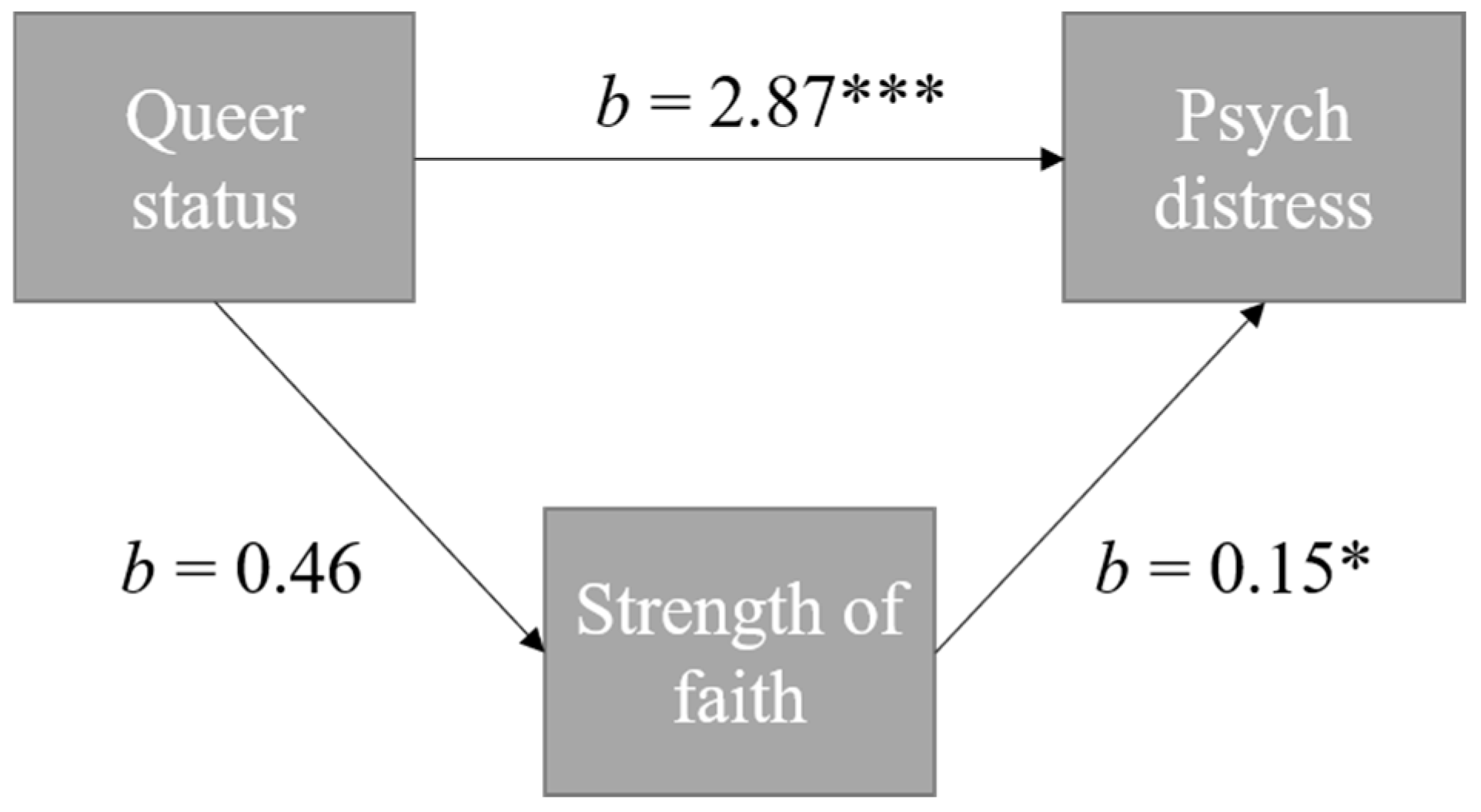
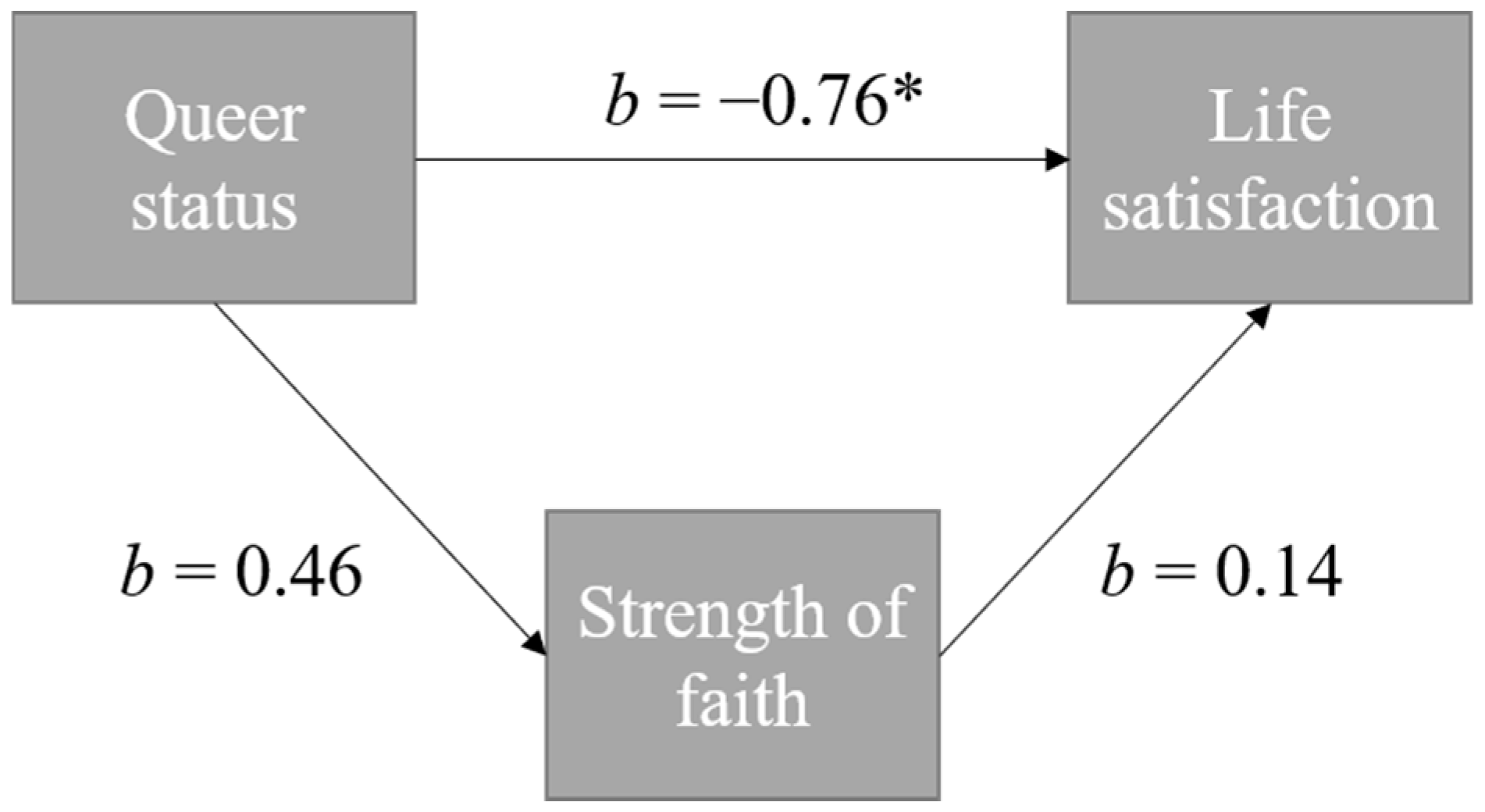
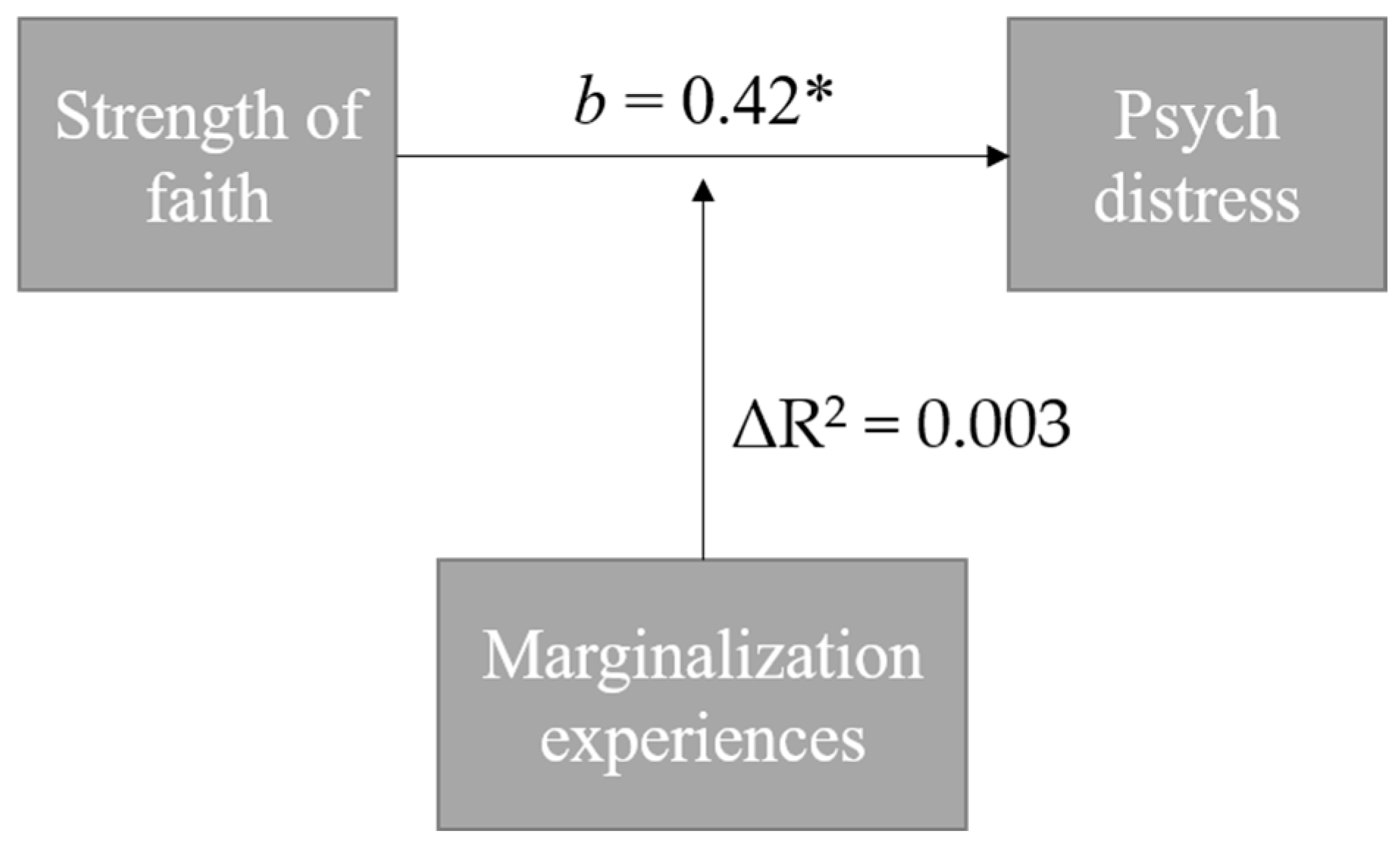
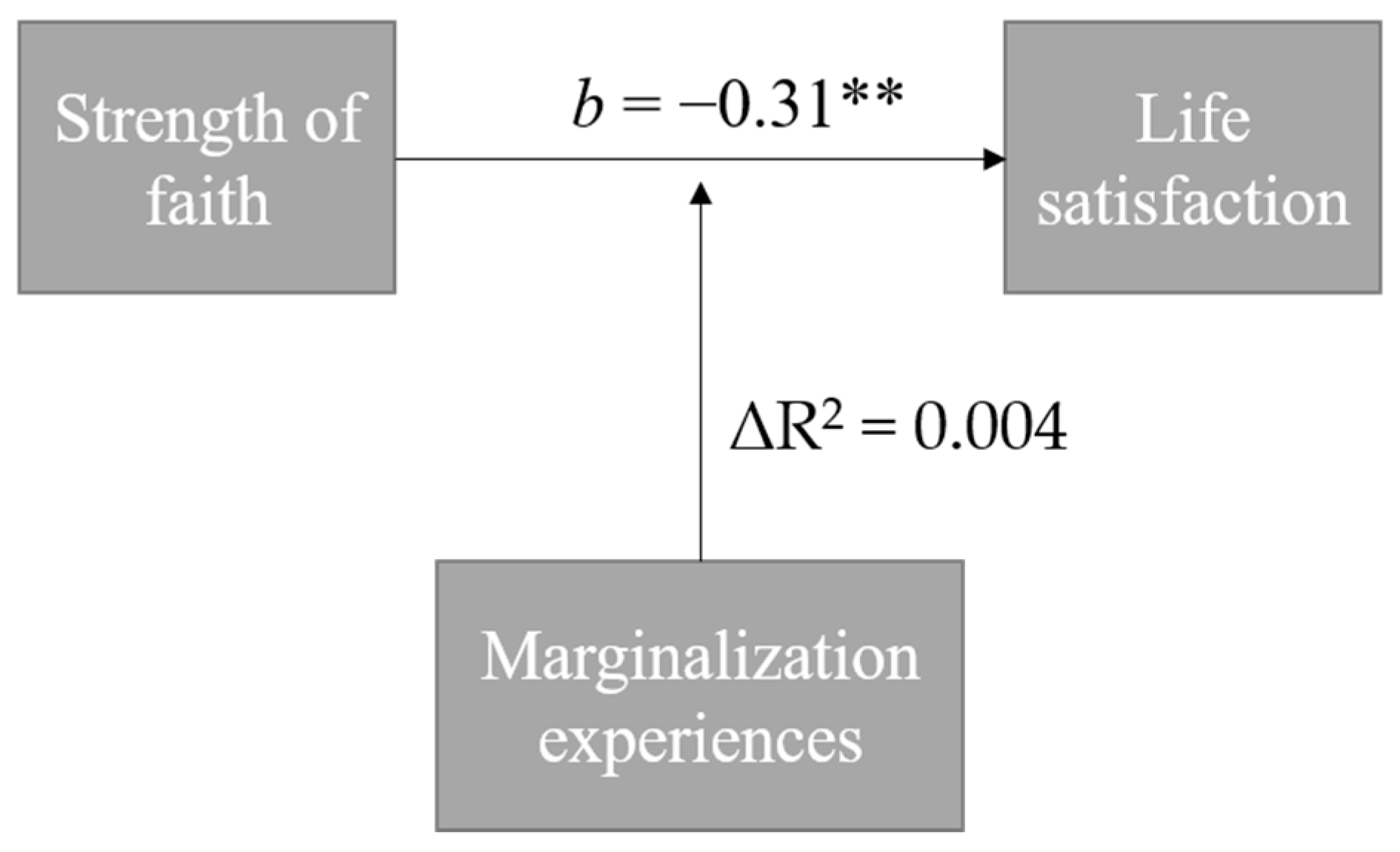
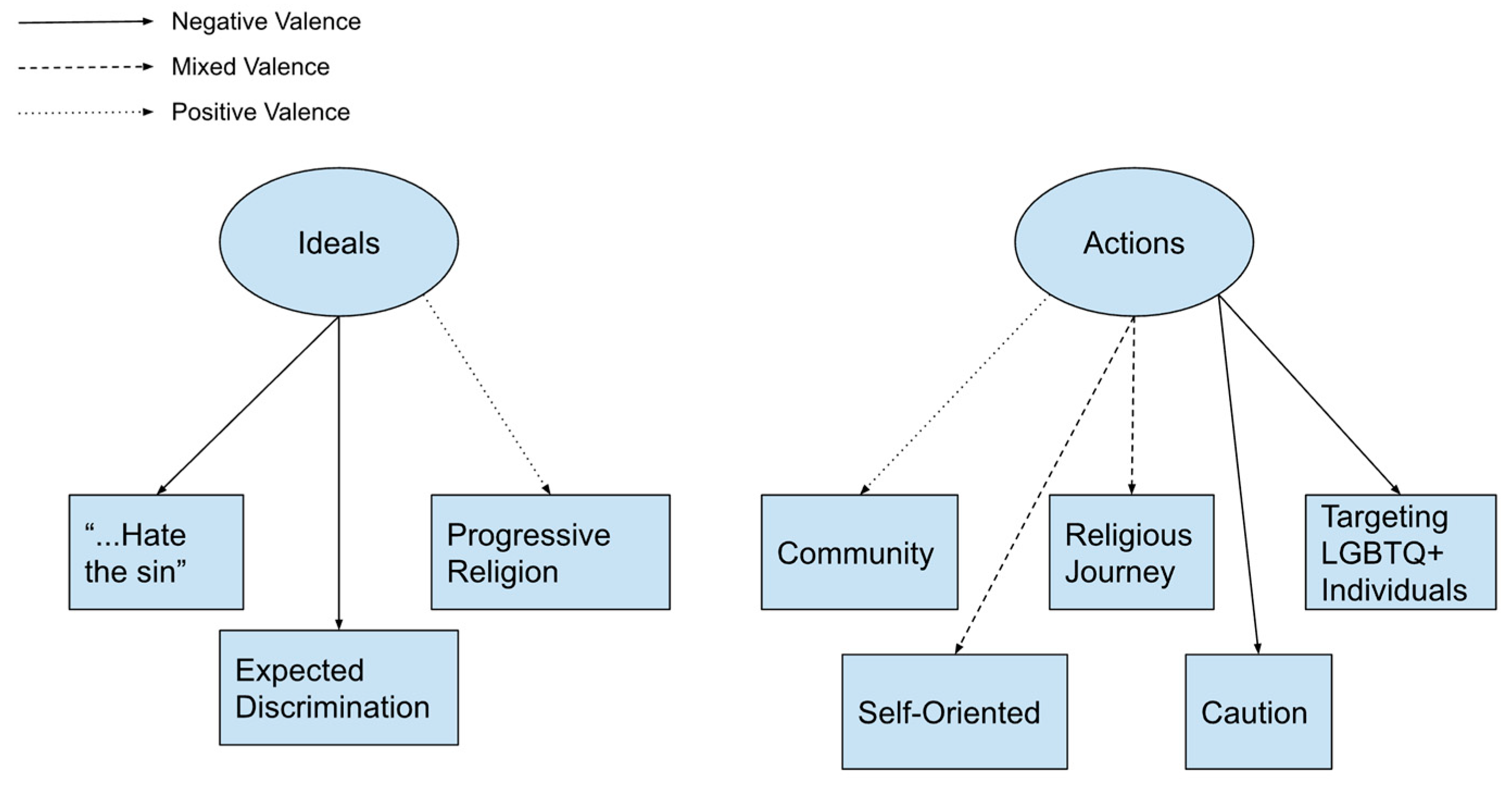
| Item | Frequency | Percent |
|---|---|---|
| Gender | ||
| Woman | 297 | 47.4 |
| Man | 219 | 35.0 |
| Non-Binary | 104 | 16.6 |
| Prefer to self-describe | 4 | 1.0 |
| Transgender Status | ||
| Transgender | 60 | 9.6 |
| Non-binary | 102 | 16.3 |
| Cisgender | 464 | 74.1 |
| Sexuality | ||
| Straight/Heterosexual | 331 | 52.9 |
| Attracted to multiple genders | 192 | 30.7 |
| Gay/Homosexual | 74 | 11.8 |
| Asexual or aromantic | 29 | 4.5 |
| Predictor | Outcome/ Interaction | b | SE | t | p | 95% CI |
|---|---|---|---|---|---|---|
| Mediation | ||||||
| Queer status | Distress | 2.87 | 0.40 | 7.25 | <0.001 | [2.09, 3.65] |
| Life satisfaction | −0.76 | 0.23 | −3.26 | 0.001 | [−1.22, −0.30] | |
| αβ (strength of faith) | 0.07 | 0.05 | [−0.003, 0.19] | |||
| Moderation | ||||||
| Strength of faith | Distress | 0.42 | 0.19 | 2.22 | 0.027 | [0.05, 0.79] |
| Life satisfaction | −0.31 | 0.11 | −2.75 | 0.006 | [−0.53, −0.09] | |
| αβ (marginalization) | −0.01 | 0.01 | −1.55 | 0.123 | [−0.03, 0.003] | |
Disclaimer/Publisher’s Note: The statements, opinions and data contained in all publications are solely those of the individual author(s) and contributor(s) and not of MDPI and/or the editor(s). MDPI and/or the editor(s) disclaim responsibility for any injury to people or property resulting from any ideas, methods, instructions or products referred to in the content. |
© 2024 by the authors. Licensee MDPI, Basel, Switzerland. This article is an open access article distributed under the terms and conditions of the Creative Commons Attribution (CC BY) license (https://creativecommons.org/licenses/by/4.0/).
Share and Cite
Baird, R.; Hutchins, C.H.; Kosanovich, S.E.; Dabbs, C.R. Queer Experiences of Religion: How Marginalization within a Religion Affects Its Queer Members. Sexes 2024, 5, 444-460. https://doi.org/10.3390/sexes5040032
Baird R, Hutchins CH, Kosanovich SE, Dabbs CR. Queer Experiences of Religion: How Marginalization within a Religion Affects Its Queer Members. Sexes. 2024; 5(4):444-460. https://doi.org/10.3390/sexes5040032
Chicago/Turabian StyleBaird, Rebecca, Camryn H. Hutchins, Seth. E. Kosanovich, and Christopher R. Dabbs. 2024. "Queer Experiences of Religion: How Marginalization within a Religion Affects Its Queer Members" Sexes 5, no. 4: 444-460. https://doi.org/10.3390/sexes5040032
APA StyleBaird, R., Hutchins, C. H., Kosanovich, S. E., & Dabbs, C. R. (2024). Queer Experiences of Religion: How Marginalization within a Religion Affects Its Queer Members. Sexes, 5(4), 444-460. https://doi.org/10.3390/sexes5040032






